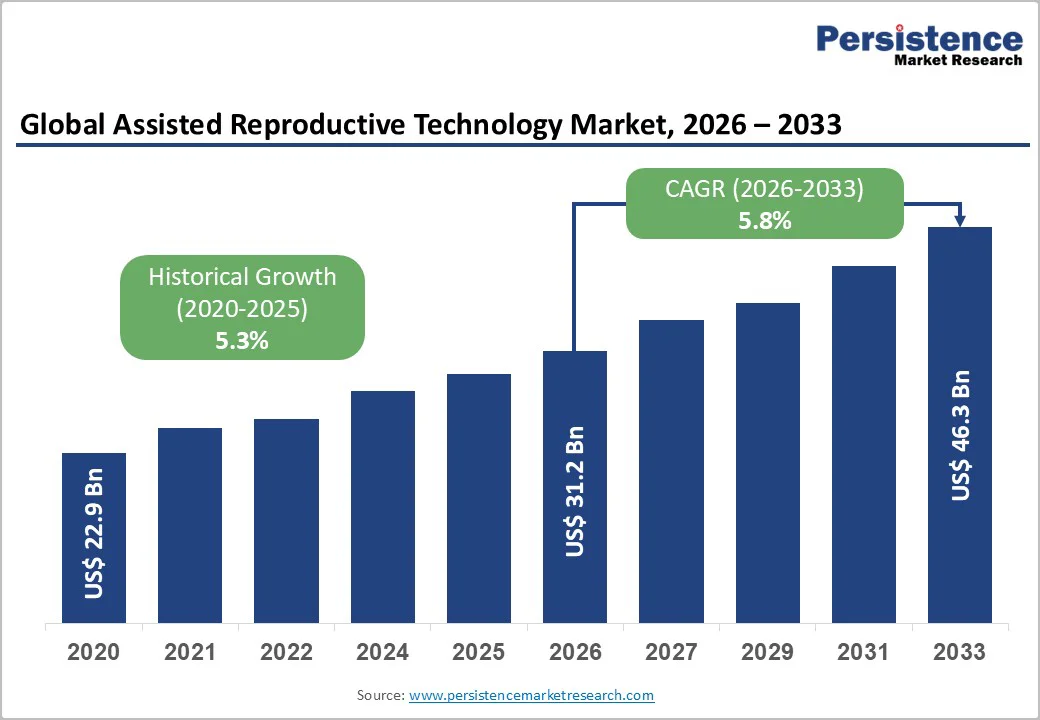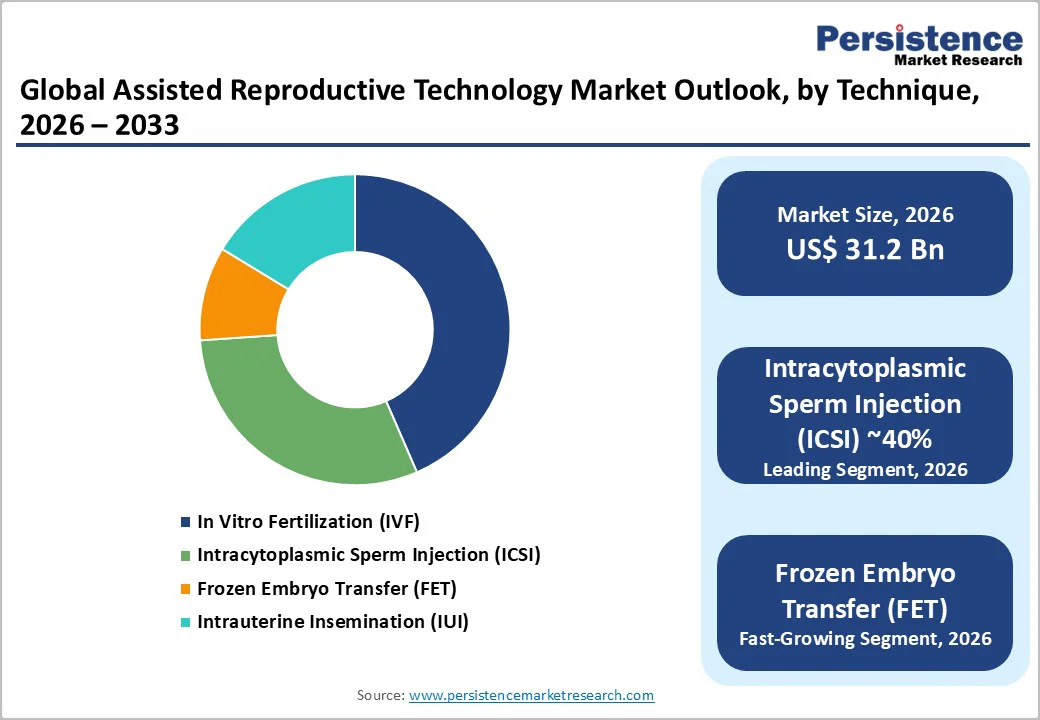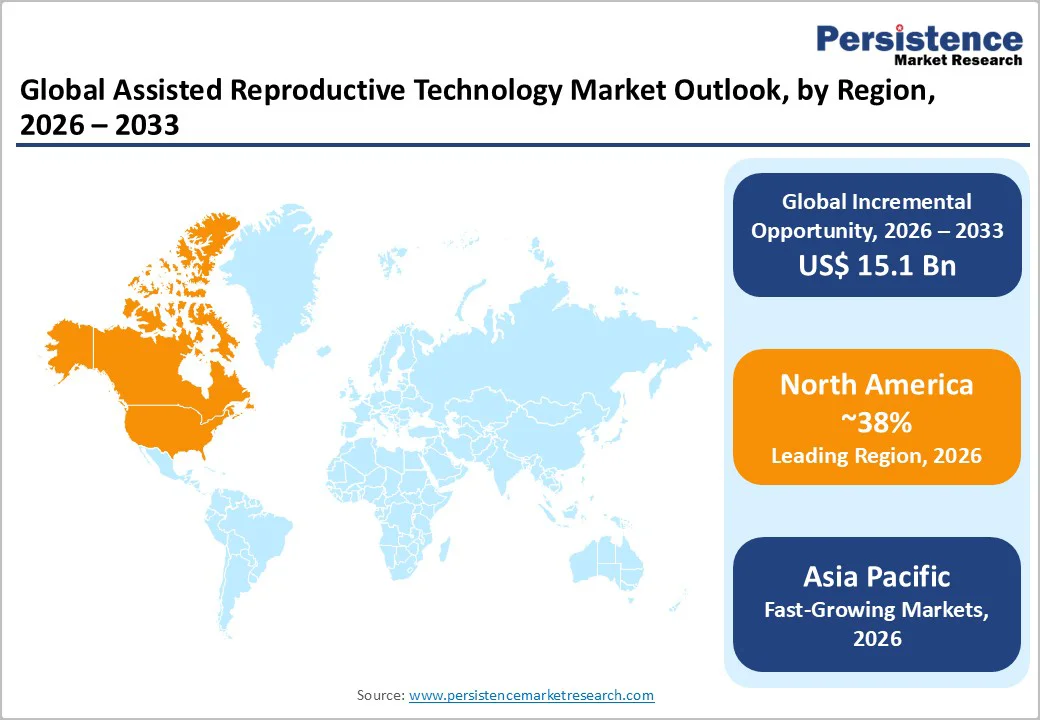ID: PMRREP34642| 200 Pages | 11 Dec 2025 | Format: PDF, Excel, PPT* | Healthcare

The global assisted reproductive technology market size is likely to value at US$31.2 billion in 2026 and projected to reach US$46.3 billion by 2033 growing at a CAGR of 5.8% during the forecast period from 2026 to 2033.
Assisted reproductive technology focuses on procedures and techniques that help couples overcome infertility. It includes treatments such as in vitro fertilization (IVF), intracytoplasmic sperm injection (ICSI), cryopreservation, and genetic testing. Rising infertility rates, delayed parenthood, and growing awareness of fertility options are driving market growth globally. Key players provide culture media, lab equipment, consumables, and full-service ART solutions, while fertility clinics and hospitals expand access.
| Key Insights | Details |
|---|---|
|
Assisted Reproductive Technology Market Size (2026E) |
US$31.2 Bn |
|
Market Value Forecast (2033F) |
US$46.3 Bn |
|
Projected Growth (CAGR 2026 to 2033) |
5.8% |
|
Historical Market Growth (CAGR 2020 to 2024) |
5.3% |

The growing adoption of elective egg freezing has emerged as a major driver as more women choose to preserve their fertility proactively. This trend is strongly associated with changing societal dynamics, where women are increasingly prioritizing career advancements, higher education, and financial independence before planning a family. Elective oocyte cryopreservation offers the assurance of using younger, healthier eggs later in life, improving chances of successful conception beyond natural reproductive decline. Technological advancements such as vitrification techniques have improved egg survival rates post-thawing, making the procedure more reliable and clinically acceptable.
Additionally, shifting cultural attitudes toward delayed parenthood, rising age of first-time pregnancies, and awareness campaigns by fertility clinics have increased acceptance of elective egg freezing. The availability of corporate reimbursement programs, especially among multinational companies, further makes this option financially feasible. As fertility preservation becomes part of preventive reproductive planning, women increasingly consider egg freezing as an empowerment tool that supports reproductive autonomy, improves family planning flexibility, and enhances long-term fertility outcomes, thereby accelerating ART market adoption worldwide.
Limited gamete availability remains one of the most critical restraints within the assisted reproductive technology (ART) market. Obtaining qualified egg and sperm donors involves stringent screening protocols, including genetic testing, infectious disease screening, age criteria, lifestyle evaluation, and psychological counselling. Due to these strict eligibility guidelines, the pool of acceptable donors becomes significantly smaller. Moreover, donor recruitment is highly dependent on awareness, social acceptance, and compensation policies, which vary widely across regions. Cultural stigma, privacy concerns, and fear of identity disclosure discourage many potential donors, particularly in Asian, Middle Eastern, and conservative societies. Limited diversity in donors further limits suitability, especially for patients seeking specific ethnic, phenotypic, or hereditary matches.
Availability constraints often prolong treatment timelines, increase waiting periods, and compel patients to shift clinics or countries for better donor access. For single women, LGBTQ+ couples, and cross-border patients, dependency on donor gametes is even higher, leading to rising treatment delays and higher costs. Additionally, regulatory restrictions on donor anonymity and the number of offspring per donor further reduce donor accessibility, ultimately affecting ART cycle volume and success rates.
Fertility preservation for oncology patients is emerging as one of the most significant growth opportunities in the assisted reproductive technology (ART) market. Rising cancer survival rates among adolescents and young adults have made safeguarding long-term reproductive potential a critical aspect of comprehensive oncology care. Treatments such as chemotherapy, radiation, and stem-cell transplants often cause irreversible gonadal damage, driving strong demand for pre-treatment preservation options, including sperm banking, oocyte freezing, embryo cryopreservation, and ovarian tissue banking.
A key driver of this opportunity is the adoption of AI-powered fertility assessment and workflow automation. Advanced tools now enable rapid ovarian reserve analysis, gamete viability prediction, and personalized optimization of stimulation protocols for urgent oncology timelines, while supporting quality control in cryopreservation labs. For example, in September 2025, Hanahealth, the IVF arm of DSS Imagetech, partnered with South Korea’s Kai Health introduced its AI-based embryo assessment tool, Vita Embryo, to IVF labs across India, highlighting how AI can improve efficiency, accuracy, and patient outcomes in fertility preservation.
Globally, healthcare systems are recognizing the emotional and psychological importance of enabling biological parenthood post-recovery. Developed countries increasingly offer insurance support for onco-fertility, while emerging markets are establishing dedicated fertility preservation units in cancer hospitals, creating a favorable environment for market expansion and innovation.
Intracytoplasmic Sperm Injection (ICSI) accounts for the highest share because it directly addresses a major cause of infertility, male-factor issues, which represent a significant proportion of ART cases globally. Unlike conventional IVF, which depends on natural sperm-egg interaction, ICSI allows embryologists to manually inject a single healthy sperm into the egg, dramatically improving fertilization likelihood even when sperm count, motility, or morphology is poor. Additionally, ICSI is routinely used for couples with past IVF failures, low ovarian reserve, older maternal age, unexplained infertility, or poor embryo development, making it widely applicable across patient categories. Clinics often prefer ICSI because it increases the predictability of outcomes and optimizes success rates per retrieval cycle. ICSI also ensures the creation of multiple embryos, enabling future frozen transfer cycles, which further increases procedural volume. These clinical advantages, coupled with patient expectations for higher success probability in a single attempt, have led ICSI to dominate the ART market share.
Fertility clinics account for the highest share because they operate as highly specialized centers dedicated solely to reproductive treatment pathways, unlike hospitals that juggle multiple clinical priorities. These clinics offer end-to-end services, including diagnostics, IVF stimulation cycles, embryology labs, genetic screening, counselling, and cryopreservation under one integrated setup, which attracts higher patient volumes. Their infrastructure is optimized specifically for IVF workflows, ensuring better cycle monitoring, faster turnaround, and personalized clinical attention. Fertility clinics also invest heavily in embryology technology, incubators, culture media, and digital tracking systems, leading to higher perceived success rates. Additionally, most infertility treatments are elective, privately paid, and time-sensitive; patients prefer clinics providing confidentiality, flexible appointments, and transparent cost plans. Rapid expansion of private IVF networks globally has further reinforced their dominant share.

North America leads the global assisted reproductive technology (ART) market due to its advanced healthcare infrastructure, high patient awareness, and well-established fertility clinic networks. The United States, the region’s largest contributor, reports over 430,000 ART cycles annually, resulting in nearly 96,000 births, representing around 2–3% of all national births. Growth is driven by rising infertility rates, delayed parenthood, and increased social acceptance of fertility treatments. Advanced practices such as egg freezing, fertility preservation for medical conditions, and preimplantation genetic testing are increasingly adopted.
Additionally, corporate health plans covering ART procedures, combined with innovations in embryo culture, lab automation, and AI-assisted embryo selection, enhance treatment success and accessibility. The focus on personalized, patient-centric fertility solutions strengthens the U.S.’s leadership role, making North America the most developed and influential region in the global ART landscape.
Europe continues to show robust growth and uptake of assisted reproductive technology (ART), underpinned by extensive data from governmental and professional registries. According to European Society of Human Reproduction and Embryology (ESHRE) data, in 2021 there were 1,103,633 ART treatment cycles up ~20% from 2020 across 37 European countries. In 2022, among the 960,347 cycles reported from 39 European nations, treatments included IVF, ICSI, frozen embryo transfers, oocyte donation, pre-implantation genetic testing (PGT), and intrauterine insemination (IUI).
Clinical pregnancy and live-birth statistics remained broadly stable: for fresh IVF/ICSI cycles, pregnancy per transfer hovered around 32–33%, while frozen embryo transfers saw slightly higher success. The trend toward single-embryo transfer has gained traction, reducing multiple pregnancies: by 2022, single-embryo transfers accounted for 62.6% of transfers, and twin/triplet deliveries declined. Despite Europe’s overall fertility rate being below replacement level, online studies have reported a 5.4% drop in births in 2023, and increasing reliance on ART suggests growing demand as couples delay parenthood. Overall, Europe remains a global leader in ART access, utilization, and technological adoption, with expanding clinic networks, stable success rates, and a continuing shift toward safer singleton births.
Assisted reproductive technology (ART) has gained significant policy and healthcare momentum across Asia Pacific. In China, ART is now covered under health insurance across all 31 provinces, autonomous regions, and the Xinjiang Production and Construction Corps, reflecting a strong government commitment to reducing fertility-related financial barriers. Similarly, the city of Jingmen in Hubei Province recently announced subsidies of up to 10,000 yuan to support ART procedures, further easing the economic burden for couples seeking treatment.
Across the Asia Pacific region, ART adoption is accelerating due to rising infertility rates, urbanization, delayed parenthood, and growing awareness of fertility options. Countries including China, India, Japan, South Korea, Australia, and Southeast Asian nations are witnessing increasing demand driven by lifestyle changes, stress, pollution, and late marriages. The expansion of private fertility clinics and technologically advanced ART centers is improving access, affordability, and treatment quality for both domestic patients and medical tourists.
Rapid adoption of innovations such as improved IVF protocols, embryo vitrification, genetic testing, and cryopreservation is enhancing success rates and patient confidence. With supportive government policies, maturing infrastructure, and rising acceptance of fertility treatments, the Asia Pacific region is positioned to remain a major engine of growth and innovation in the global ART market over the coming decade.

The global assisted reproductive technology (ART) market is highly competitive, characterized by rapid innovation and continuous adoption of advanced reproductive solutions. Key players compete through technological advancements in IVF, ICSI, embryo culture, cryopreservation, and genetic screening to improve success rates and patient outcomes. Competition also focuses on expanding geographic presence, enhancing clinic networks, and offering integrated, patient-centric services. Pricing strategies, personalized treatment packages, and partnerships with hospitals or research centers further differentiate providers
The global assisted reproductive technology market is projected to be valued at US$31.2 Bn in 2026.
Increasing infertility among couples due to delayed parenthood, lifestyle changes, stress, pollution, and medical conditions fuels demand for ART treatments.
The global market is poised to witness a CAGR of 5.8% between 2026 and 2033.
Adoption of AI-assisted embryo selection, lab automation, and digital monitoring can improve success rates and operational efficiency.
North America is the Leading Region in the Global Assisted Reproductive Technology Market.
| Report Attribute | Details |
|---|---|
|
Historical Data/Actuals |
2020 - 2024 |
|
Forecast Period |
2026 - 2033 |
|
Market Analysis |
Value: US$ Bn |
|
Geographical Coverage |
|
|
Segmental Coverage |
|
|
Competitive Analysis |
|
|
Report Highlights |
|
By Technique
By Procedure
By End-user
By Region
Delivery Timelines
For more information on this report and its delivery timelines please get in touch with our sales team.
About Author